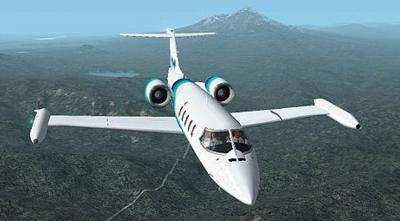Flight Appeared Normal Up To The Accident Sequence, Low Level Wind Shear Advisory Was In Effect
The NTSB has released a preliminary report from an accident which occurred May 15 involving a Gates Learjet 35A on approach to Teterboro Airport. The two people on board, the captain and first officer, were fatally injured in the accident. There were no injuries reported to anyone on the ground.

According to the report, the flight appeared to be normal up until the approach. the airplane, operated by Trans-Pacific Jets, departed controlled flight while on a circling approach to runway 1 at the Teterboro Airport (TEB), Teterboro, New Jersey, and impacted a commercial building and parking lot. The airplane was destroyed by impact forces and postcrash fire.
The airplane was registered to A&C Big Sky Aviation LLC and operated by Trans-Pacific Air Charter LLC under the provisions of 14 Code of Federal Regulations Part 91 as a positioning flight. Visual meteorological conditions prevailed, and an instrument flight rules (IFR) flight plan was filed. The flight departed from the Philadelphia International Airport (PHL), Philadelphia, Pennsylvania, about 1504 and was destined for TEB.
The accident flight was the crewmembers' third flight of the day. The first flight departed TEB about 0732 on a Part 91 positioning flight and landed about 0815 at the Laurence G. Hanscom Field (BED), Bedford, Massachusetts, where they refueled and boarded a passenger. They departed BED about 1009 on a Part 135 on-demand charter flight and landed at PHL about 1104.
The captain filed an IFR flight plan to TEB planning a 28-minute flight at a cruising altitude of flight level 270 (27,000 feet) with a cruise speed of 441 knots and a departure time of 1430. After departure about 1504, the flight was cleared to climb to 4,000 feet above mean sea level (msl). The flight reached a maximum altitude of 4,000 feet msl. About 1515, the flight was cleared to descend to 3,000 ft msl. The New York Terminal Radar Approach Control (TRACON) cleared the flight for the TEB ILS Runway 6 Approach, circle to land runway 1. TRACON instructed the flight to switch frequencies and contact TEB air traffic control (ATC) about 9 miles from the airport; however, the flight did not check onto the ATC's frequency until 4 miles from the airport. ATC cleared the flight to land on runway 1 and issued the TEB winds of 320 degrees at 16 knots, gusting to 32 knots.
Radar track data indicated that the flight did not start its right circling turn until it was less than 1 mile from the approach end of runway 6. According to TEB ATC, aircraft typically start the right turn at the final approach fix for runway 6, which is located 3.8 nm from the approach end of runway 6.

A TEB ATC controller reported that he observed the airplane bank hard to the right and he could see the belly of the airplane with the wings almost perpendicular to the ground. The airplane then appeared to level out for just a second or two before the left wing dropped, showing the entire top of the airplane. Other ground witnesses also reported that they observed the airplane in a right turn with the wings in a high angle of bank. Some witnesses described seeing the airplane's wings "wobbling" before the left wing dropped and the airplane descended to the ground. Security video cameras installed at numerous commercial buildings also captured the last moments of the flight, showing the airplane at high angles of bank. One security camera showed the airplane in a steep right wing low, nose down attitude at impact. The accident site was located on a 180-degree bearing about 1/2 nautical miles from the threshold of runway 1 at TEB. The main wreckage was distributed in the parking lots of commercial
businesses. The wreckage path and debris field was about 440 ft. long on a 135- degree heading, and 3 buildings and 16 vehicles were damaged by impact or fire. Although impact forces and postcrash fire destroyed and consumed much of the airplane, the examination of the wreckage revealed that all components of the airplane were located at the accident site.
The cockpit voice recorder (CVR) was located in the wreckage and was sent to the National Transportation Safety Board's (NTSB) Vehicle Recorder Laboratory. The CVR was auditioned by NTSB senior management staff and found to be operating at the time of the accident. A CVR Group will be formed and a transcript of the flight will be produced.
Four other airplane components that store non-volatile memory (NVM) and an iPhone were collected and sent to the NTSB Vehicle Recorder Laboratory for examination. All 4 components and the iPhone exhibited impact and fire damage. The 4 components were: 2 Honeywell N1 Digital Electronic Engine Controls (DEEC); 1 Flight Management System (FMS); and 1 Honeywell KGP-56 Enhanced Ground Proximity Warning System (EGPWS).
At 1452, the surface weather observation at TEB was: wind 350 degrees at 20 knots gusting to 30 knots; 10 miles visibility; scattered clouds at 4,500 ft; temperature 19 degrees C; dew point 6 degrees C; altimeter 29.75 inches of mercury.
The TEB automated terminal information services (ATIS) Z was in effect at the time of the accident. The 1451 ATIS Information Z stated that the current weather was: wind 350 degrees at 18 knots gusting to 29 knots; visibility 10; light rain, 5,500 ft scattered; temperature 18 degrees C; dew point 6 degrees C; altimeter 29.74 inches of mercury. ILS Runway 6 circle approach in use…Low level wind shear advisory in effect… ."
(Top image from file. Not accident airplane. Lower image from YouTube video captured at the accident site)
 ANN's Daily Aero-Term (04.25.24): Airport Rotating Beacon
ANN's Daily Aero-Term (04.25.24): Airport Rotating Beacon ANN's Daily Aero-Linx (04.25.24)
ANN's Daily Aero-Linx (04.25.24) Klyde Morris (04.22.24)
Klyde Morris (04.22.24) Airborne 04.24.24: INTEGRAL E, Elixir USA, M700 RVSM
Airborne 04.24.24: INTEGRAL E, Elixir USA, M700 RVSM Airborne 04.22.24: Rotor X Worsens, Airport Fees 4 FNB?, USMC Drone Pilot
Airborne 04.22.24: Rotor X Worsens, Airport Fees 4 FNB?, USMC Drone Pilot




